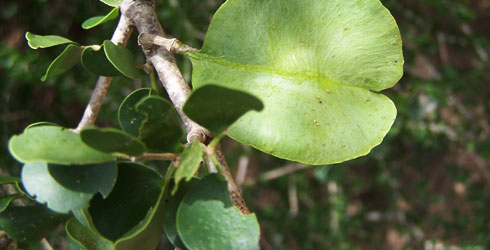Bulnesia sarmientoi (Palo Santo)
Palo Santo is a member of the Zygophyllaceae family and is one of the most emblematic trees of the Dry Chaco region in Paraguay. The wood's quality, aroma and medicinal uses are highly valued by the local inhabitants, the Chaqueños.

The Palo Santo tree © R Elsam
The wood from Palo Santo is characterised by its:
- attractive grain
- smooth shine
- fine texture
- very pleasant smell
The sapwood is white-yellow in colour and the heartwood is a beautiful green to greenish-brown colour with blue-gold tones. This colouring is due to the calcium oxalate crystal content in its fibres.
Uses
The wood is extensively used for:
- lathe work
- furniture
- handicrafts
- smoking pipes
- mortars
- axes
An essential oil known as guayacol is extracted from its wood and used in the perfume industry.
The oil is highly prized by the inhabitants of the Dry Chaco due to its healing properties for skin wounds. A decoction of the bark is used to treat stomach ailments.
Resins are extracted from its sawdust and these are used to make varnishes and paints.
During indigenous marriage ceremonies, and in the absence of witnesses, the couple must plant a seedling of Palo Santo as a symbol of linking their destinies.
Species detail
-

Taxonomy
The Palo Santo tree is deciduous with rough grey bark. Find out more about the appearance of this tree.
-

Distribution and habitat
Bulnesia sarmientoi is endemic to the Dry Chaco and found in Argentina, Bolivia and Paraguay. Find out more about the dry forest regions of the Chaco.
-

References
Find more references material for Bulnesia sarmientoi.
Images

Photo credit: Richard Elsam

Photo credit: Juana De Egea

Photo credit: María Peña-Chocarro

Photo credit: José Luis Cartes

Bulnesia sarmientoi.
© María Peña-ChocarroGlossary
Decoction
A decoction involves first mashing, and then boiling in water to extract oils, volatile organic compounds, and other chemical substances.
About the author
Juana De Egea
Formerly Solanaceae Database Technician, Department of Botany
